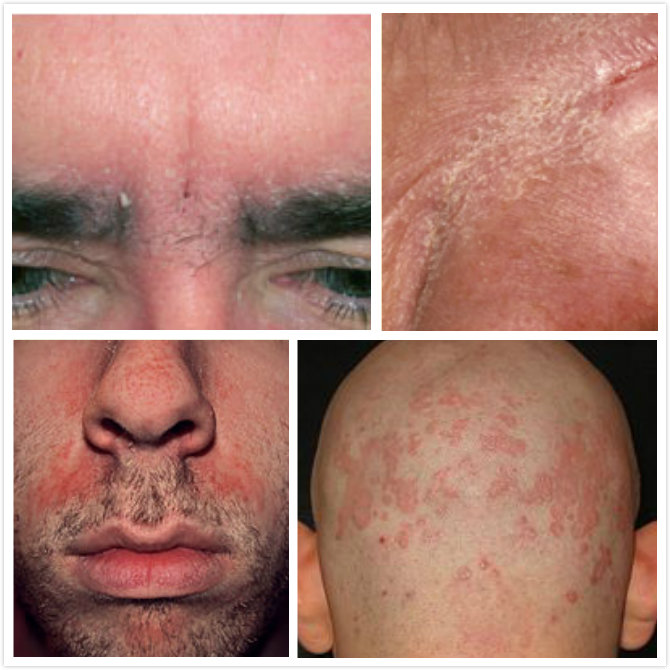Seborrheic dermatitis or seborrheic eczema is a skin condition that often affects young adults, although it can occur at any age. Around 1-3% of the adult population are affected, mostly in men. It can also affect babies, leading to a condition called cradle cap. The rash is accompanied by the presence of dandruff which is often treated by an anti-yeast shampoo or cream. However, the condition tends recur, thus necessitating regular use of antifungal products to keep it away.
Symptoms of Seborrheic Dermatitis on Face
This skin condition tends to affect areas of the body that have the most oil-producing glands. Therefore, seborrheic dermatitis on face is very common.
Symptoms include scaling, formation of dandruff, itchiness and flakiness of the skin. As the condition gets worse, a skin rash can also develop, which looks like patches of round/oval, red, greasy skin. The patches may vary in size, appear slightly raised, and may form yellow to brown crusts. Some people may also develop inflammation in the outer ear and the eyelids.

In severe cases of seborrheic dermatitis, face, neck, ears, scalp, chest, armpits, and groins are affected. This usually occurs in people who have weakened immune systems, such as those who have HIV/AIDS.
It may be difficult to distinguish this from other skin conditions, so you must consult a dermatologist (a specialist in skin problems) to get proper diagnosis and treatment.
Home Remedies for Seborrheic Dermatitis on Face
1. Wash Your Face
For seborrheic dermatitis, face hygiene is important. Wash off excess oil and dead skin cells to reduce scales using mild soap to avoid irritating your skin. Avoid using alcohol-based products to clean the skin. Moisturize with non-oily, non-comedogenic products that will not clog the pores.
2. Use Medicated Shampoos
Although medicated shampoos are usually used for the scalp, they may also be used for treating seborrheic dermatitis, face. You can rub the shampoo gently on affected areas and leave it on for a short time before rinsing. Recommended products include shampoos containing:
- Pyrithione zinc (like Head & Shoulders)
- Selenium (such as Selsun Blue)
- Antifungal medications
- Tar (such as Neutrogena T/Gel and DHS Tar)
- Salicylic acid (like Neutrogena T/Sal)
It is best to consult your doctor before using any of these shampoos, especially if you are pregnant, and to follow instructions for use.
3. Massage Oils into the Scales
To remove scales, massage oil on affected areas and leave it on about 30 minutes. Wash off the oil and softened scales using a wash cloth and warm water. You can use any of these types of oil:
- Mineral oil
- Coconut oil
- Olive oil
4. Apply Warm Compress
Apply warm compress particularly if you have seborrheic dermatitis, face with scaly patches on the eyelids. Make a warm compress with wash cloth dipped in warm water. Place the warm compress over the eyelids until scales become soft and can be easily wiped away. Avoid peeling away the scales if they do not come off easily to reduce your risk of skin break or infection.
5. Avoid Buildup of Oils
To prevent further build-up of oil, keep your hair away from your face and shave off your moustache or beard. You can also try wearing a hat which can help absorb oil from your skin and scalp.
6. Try OTC Medications
Use over-the-counter medications to reduce inflammation and itching, fight infection and promote healing. These medications may include cortisone creams, antifungal creams and antibacterial creams. Consult your doctor about using these products if you are pregnant.
7. Treat Itching
It is important to treat itchy skin to prevent scratching which can lead to skin infection and inflammation. You can usecalamine lotion orhydrocortisone cream, but avoid using these continuously for long periods.
8. Manage Stress
Stress is sometimes related to hormonal changes and can make you prone to skin problems. It is therefore important to manage stress by learning some relaxation techniques, getting enough sleep, and getting more exercise.
9. Try Some Natural Remedies
Ask your doctor about alternative medicine and natural remedies to treat your skin condition. These may include:
- Aloe, which may come from a plant as a gel or from commercial preparations to soothe your skin.
- Fish oil supplements, which contain omega-3 fatty acids that are good for skin health.
- Tea tree oil, which has antiseptic properties that prevent infection and promote healing.
Medical Treatments for Seborrheic Dermatitis on Face
If your seborrheic dermatitis on face does not improve with home remedies, consult your doctor about these treatments:
- Prescription-strength preparations containing hydrocortisone, desonide or fluocinolone to reduce inflammation.
- Antifungal shampoo with prescription-strength ketoconazole, which may be effective when used alternately with a product containing clobetasol.
- Oral antifungal medication such as terbinafine (Lamisil). This is not commonly used because of the possible serious side effects, including allergic reactions or liver problems.
- Medications that improve immune system function, such as creams and lotions containing pimecrolimus (Elidel) and tacrolimus (Protopic). Compared to corticosteroids, these are more effective and have fewer side effects. However, these are more costly and have been linked to an increased risk of cancer.
- Medicated creams or gels that contain metronidazole, which can fight bacterial infection.
- A combination of light therapy and oral medication (psoralen), which has been found to be effective for seborrheic dermatitis on face.
